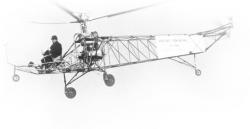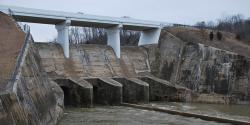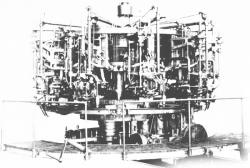Maine's heavy snows led turnpike maintenance personnel to bring "left-handed" snow plows into prominence. By using left-handed and traditional right-handed plows in tandem, they were able to distribute snow more evenly - an important advance that has been emulated by many highway maintenance crews across the country.
USA

The Wildcat's innovative "Sto-Wing" mechanism developed on the XF4F-4 prototype by Leroy (Roy) Grumman (1895-1982), a founder of Grumman Aircraft Engineering Corporation, was crucial to the U. S. Navy's success during World War II.
The idea of a folding wing was not new: as early as 1920, F.M. Osborne patented a high-wing monoplane with folding wings, but never produced this design. A 1928 plane with folding wings designed by W. Leonard Bonney crashed on its first flight.

America's first practical helicopter, it pioneered the single main rotor concept that became the predominant helicopter configuration throughout the world. The principles that were developed and demonstrated by the VS-300 had direct application in the design of the early mass-production helicopter, marking the beginning of the world's rotorcraft industry.
The initial flight of the VS-300 was piloted by its designer, Igor I. Sikorsky (1889-1972), on September 14, 1939, in Stratford, Connecticut.

The Miami Conservancy District flood control project was the direct result of the disastrous flood of 1913, when waters from the Miami, Stillwater, and Mad rivers flooded Dayton and surrounding communities in the Miami Valley. More than 400 lives were lost and property damage exceeded $100 million. When Dayton flooded, great fires raged, adding to the devastation. Many believed that the area would never recover.
- Concrete Conduit
- Dry Dam
- Earth-Core
- Flood Control
- Flood Prevention Committee
- Great Depression
- Levee
- Mad River
- Miami Conservancy District
- Miami River
- Retardation Basin
- Stillwater River
- 1920-1929
- 1922
- 1972
- 45424
- ASCE
- Civil
- Flood Prevention Committee
- Great Dayton Flood
- Morgan, Arthur Ernest
- OH
- USA
- Water Supply & Control

The Connecticut Light & Power Company pioneered the use of pumped storage in the United States at this hydroelectric station. First operated in 1929, the Rocky River Plant had two reversible pumps that somewhat resemble large hydroelectric turbines. This permitted significant improvements in the system efficiency of the company's network of hydroelectric and thermal-electric power generating plants. Water is pumped uphill through a penstock and stored in Lake Candlewood.

The largest mine hoist in the world, it serves the two incline skipways of Shaft No. 2, almost 9,300 feet long. The overhead winding drum has a diameter of 30 feet, of which the cylindrical center section is 10 feet long. The two 10-foot long end sections taper down to a 15-foot diameter. Wire hoisting ropes (almost 27 tons) could be wound onto a small end of the cylindrical drum as the other rope unwound from the cylindrical section.

The 1.6-mile Holland Tunnel was the first underwater vehicular crossing of the Hudson River and the first tunnel specifically designed for automobiles and trucks. It dramatically reduced the time required to traverse the Hudson River, a trip previously possible only by ferry.
A major difficulty when tunneling beneath a river is to keep water and mud from inundating the workers and equipment in the tunnel. Builders of the Holland Tunnel used a shield that enveloped the work site as the excavation progressed; this also avoided obstruction of shipping traffic during construction.

Spearheaded by Hugh Cooper, the Keokuk Dam & Power Plant served as a prototype for many future power plants. The project harnessed the hydropower of the Mississippi River, between Keokuk, Iowa and Hamilton, Illinois.
The crest of the dam is nearly a mile long. The dam structure features 119 arch spans between six-foot-thick piers and a 110-foot-wide pneumatic lock. Combined with the lock, the dam reduced travel time for steamboats by nearly two hours.

Only since 1912 have glass jars and bottles been in cheap and plentiful supply for pharmaceuticals, household products, food and beverages, and an endless variety of uses. The bottle-making machine introduced the safety, standardization, quality, and convenience of glass containers. Not only did they revolutionize the industry, the Owens machines ended child labor in glass-container plants. In 1913, the National Child Labor Committee of New York City said the rapid introduction of the automatic machine did more to eliminate child labor than they had been able to do through legislation.

This low-head operating plant is representative of nineteenth-century hydropower-plant practice using many small turbines in contrast to twentieth-century use of few large turbines and generators. Its 40,000 horsepower capacity made it the largest in the country using turbines of American design (McCormick-Francis). The contemporary and larger Niagara installation used turbines of French design (Fourneyron). The entrepreneur of this plant was Francis Clergue, a lawyer, who employed as his chief engineer Hans A.E. von Schon, a German immigrant who had served with the U.S.


